|

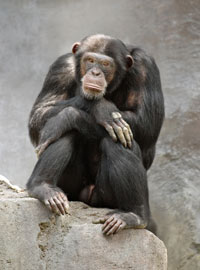 Lighter than humans, but stronger: Adults (common Chimpanzees) in the wild weigh between 40 and 65 kg (88 and 143 lb); males can measure up to 160 cm (63 inches) and females to 130 cm (51 inches), and although lighter than humans they have a pull 5-6 times stronger . This is because the muscles of chimpanzees and other primates are far more effective than those of humans. Lighter than humans, but stronger: Adults (common Chimpanzees) in the wild weigh between 40 and 65 kg (88 and 143 lb); males can measure up to 160 cm (63 inches) and females to 130 cm (51 inches), and although lighter than humans they have a pull 5-6 times stronger . This is because the muscles of chimpanzees and other primates are far more effective than those of humans.
Their bodies are covered by a coarse dark brown hair, except for the face, fingers, toes, palms of the hands and soles of the feet. Both their thumbs and their big toes are opposable, allowing a precision grip.

Warm and moist regions : Common Chimpanzees are found in the tropical forests and wet savannas of Western and Central Africa. They used to inhabit most of this region, but their habitat has been dramatically reduced in recent years.
Diet: Although omnivores, their diet is mainly vegetarian, consisting of fruits, leaves, nuts, seeds, tubers, and miscellaneous plant life supplemented by insects and small prey. There are also instances of organized hunting; in some cases, such as the killing of leopard cubs, this seems to be primarily a protective effort. However, Common Chimpanzees sometimes band together and hunt Western Red Colobus monkeys (Piliocolobus badius) for their meat. Isolated cases of cannibalism have been documented. Chimpanzees have also been known on rare occasions to attack and eat human infants.
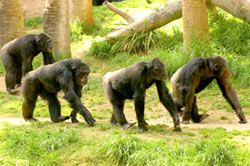 Large communities: Common Chimpanzees live in communities that typically range from 20 to more than 150 members, but spend most of their time traveling in small parties of just a few individuals. Large communities: Common Chimpanzees live in communities that typically range from 20 to more than 150 members, but spend most of their time traveling in small parties of just a few individuals.
Usually on 4, but sometimes 2: They are both arboreal and terrestrial, spending equal time in the trees and on the ground. Their habitual gait is quadrupedal, using the soles of their feet and resting on their knuckles, but they can walk upright for short distances.
A changing society: The Common Chimpanzee lives in a fission-fusion society, where mating is promiscuous, and may be found in groups of the following types: all-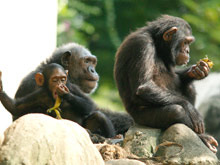 male, adult females and offspring, bisexual, one female and her offspring, or a single individual. The core of the societies are males who roam around, protecting members of the group as well as engaging in the search for food. Among males, there is generally a dominance hierarchy. However, this unusual fission-fusion social structure, "in which portions of the parent group may on a regular basis separate from and then rejoin the rest", is highly variable in terms of which particular individual chimpanzees congregate at a given time. This is mainly due to chimpanzees having a high level of individual autonomy within the fission-fusion society. Also, communities have large ranges that overlap with those of other groups. male, adult females and offspring, bisexual, one female and her offspring, or a single individual. The core of the societies are males who roam around, protecting members of the group as well as engaging in the search for food. Among males, there is generally a dominance hierarchy. However, this unusual fission-fusion social structure, "in which portions of the parent group may on a regular basis separate from and then rejoin the rest", is highly variable in terms of which particular individual chimpanzees congregate at a given time. This is mainly due to chimpanzees having a high level of individual autonomy within the fission-fusion society. Also, communities have large ranges that overlap with those of other groups.
Smaller foraging: As a result, individual chimpanzees often forage for food alone, or in smaller groups (as opposed to the much larger parent group, which encompasses all the chimpanzees who regularly come into contact and congregate into parties in a particular area). As stated, these smaller groups also emerge in a variety of types, for a variety of purposes. For example, an all-male troop may be organized in order to hunt for meat, while a bi-sexual group consisting of one mature male and one mature female may occur for the purposes of copulation. An individual may encounter certain individuals quite frequently, but have run-ins with others almost never or only in large-scale gatherings. Due to the varying frequency at which chimpanzees associate, the structure of their societies is highly complicated.

Pan: The genus Pan is now considered to be part of the subfamily Homininae to which humans also belong. Biologists believe that the two species of chimpanzees are the closest living evolutionary relatives to humans. It is thought that humans shared a common ancestor with chimpanzees and gorillas as recently as four to seven million 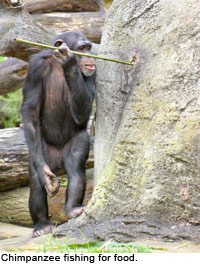 years ago, and that they have about 95 to 99.4 percent of their DNA in common with humans, with at least some of the difference occurring in 'junk' DNA. It has even been proposed that troglodytes and paniscus belong with sapiens in the genus Homo, rather than in Pan. years ago, and that they have about 95 to 99.4 percent of their DNA in common with humans, with at least some of the difference occurring in 'junk' DNA. It has even been proposed that troglodytes and paniscus belong with sapiens in the genus Homo, rather than in Pan.
Human observation: The 20th century saw a new age of scientific research into chimpanzee behavior. Prior to 1960, almost nothing was known about chimpanzee behavior in their natural habitat. In July of that year, Jane Goodall set out to Tanzania's Gombe forest to live among the chimpanzees. Her discovery of chimpanzees making and using tools was groundbreaking, as it had previously been believed that humans were the only species to do so.
 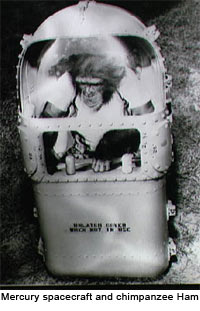
Astronaut Chimpanzee: Chimpanzees entered outer space before humans did! Chimpanzees are so intelligent that one named Ham orbited the Earth in 1961. In fact, Mercury astronaut Alan Shepard followed Ham into space three months later!
In December 1960 the 44-month old chimpanzee was trained to do simple tasks in response to electric lights and sounds, with response being timed. On January 31, 1961, Ham was secured in a Project Mercury capsule labeled MR-2 and launched from Cape Canaveral, Florida into outer space. The capsule suffered a partial loss of pressure during the flight, but Ham's space suit prevented him from suffering any harm. During the flight Ham had to push a lever within five seconds of seeing a flashing blue light; as he was taught in pre-flight training. Ham's performance in space was only a fraction of a second slower than on Earth, demonstrating that tasks could be performed in space. Ham's capsule splashed down in the Atlantic Ocean and was recovered by a rescue ship later that day.

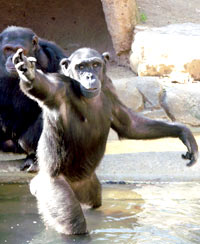 Losing our chimpanzee cousins: Unfortunately, also because they are so intelligent and that they can be taught, chimpanzees are often involved in scientific studies, or caught and sold as pets. Because so many chimpanzees have been taken from the wild, and because some people hunt chimpanzees for bushmeat (food) there has been a huge drop in their population. All these factors, in addition to the human takeover of habitat have caused these intelligent beings to become endangered. Losing our chimpanzee cousins: Unfortunately, also because they are so intelligent and that they can be taught, chimpanzees are often involved in scientific studies, or caught and sold as pets. Because so many chimpanzees have been taken from the wild, and because some people hunt chimpanzees for bushmeat (food) there has been a huge drop in their population. All these factors, in addition to the human takeover of habitat have caused these intelligent beings to become endangered.
Bonobos | Gorilla | Humans | Orangutans | Gibbons
Primates| Apes| Monkeys| Prosimians
All text is available under the terms
of the GNU Free Documentation License
|